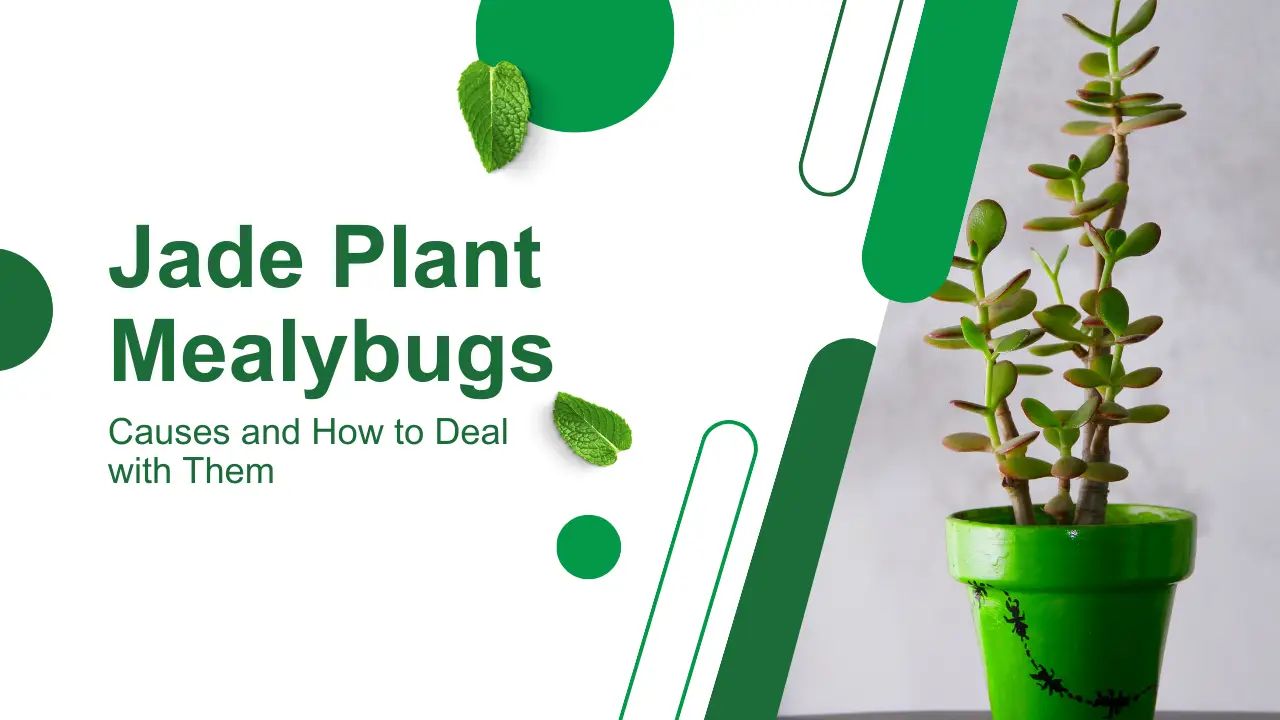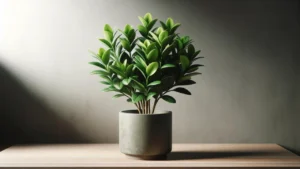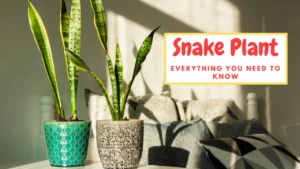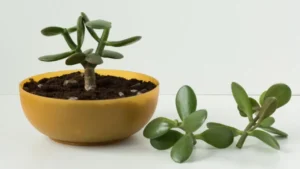Imagine one day seeing someone in white cotton material on your jade plant. There is a lot of it. But when you look closely, you realize it is more than just cotton and fluff.
Waxy pink bugs have colonized your plant and laid their eggs everywhere. Sadly, your jade has been taken hostage by mealybugs.
Mealybugs, your plant’s culprits are the bugs that will continue to breed and lay eggs if you don’t stop them. Until your plant is overrun by them. The bugs completely drain the life energy from the plant.
Of course, that’s the worst-case scenario. It doesn’t have to end that way. Your Jade plant does not have to dry up before your eyes.
So, how to save your plant from the mealybugs?
No worries, this article has your back. I will explain everything about mealybugs here, from their causes to how to prevent them. After reading this article, your precious jade plant will be free from mealybugs.
Table of Contents
How Mealybugs Attack Your Plant
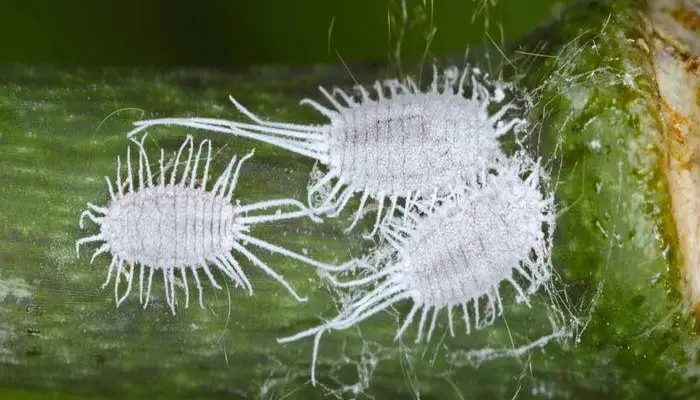
Mealybugs attack your plant in different areas. However, they all have two things in common.
First, they feed in clusters. And as soon as they find a spot, they will stay there. In the same way, other bugs follow. As a result, bugs form a cluster, which makes them easy to identify.
Second, all mealybugs suck sap from plants. A plant’s sap is a fluid that travels through the xylem cells inside the plant. Additionally, the sap is transported through phloem sieve tubes.
This sap contains xylem cells that absorb water from roots. Your plant obtains nutrients through this process.
Moreover, sap carries all these nutrients from the roots to the rest of the plant. Like in your body, blood carries all the important stuff. Also, a plant cannot go into photosynthesis without nutrients from sap.
It is most common for mealybugs to feed off sap found at stem tips and at the point where leaves connect to stems. In addition, they will feed on any new growth in or around your plant.
As a result, plant health is compromised when bugs feed on these areas. It includes stunted growth. In addition, the leaves will be yellow or wilt. If mealybugs take too much sap from your houseplant, they can die.
Additionally, mealybugs excrete wax and honeydew on your plants. Eventually, it grows a black, sooty mold. Your plant won’t die from the mold, but it will get sick. Occasionally, it grows on leaves as well as around stems. In some cases, it covers them, while in others, it appears in patches. Towards the end of this article, we will learn more about black sooty mold.
Yet, one of the worst species of mealybug is citrus mealybug. This mealybug injects a toxin into a plant as it feeds. Often, houseplants become deformed due to this toxin.
Other mealybugs feed on the plant’s roots. Whereas citrus mealybugs hide in the soil and feed on the root hairs. As a result, growth is stunted and leaves become yellow or wilted. Even leaves can fall off.
It won’t harm your plant if there are only a few mealybugs. It’s when they start breeding and dropping eggs that you should be concerned about. In either case, you need to get rid of them as soon as possible.
Signs of Mealybugs in Jade Plants
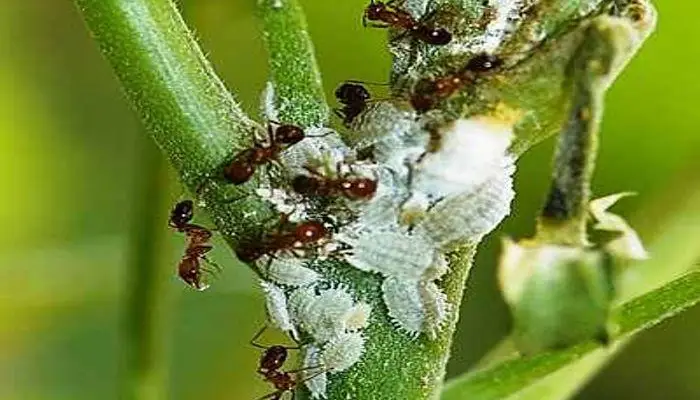
- Mealybugs can be identified by white residue on leaf and stem surfaces. Often, the substance is the insects’ eggs sacs or the insects themselves.
- There is also sticky residue on the leaves of the plants (honeydew).
- Jade plants are also likely to attract ants due to honeydew deposits.
Signs of Root Mealybugs in Jade Plants
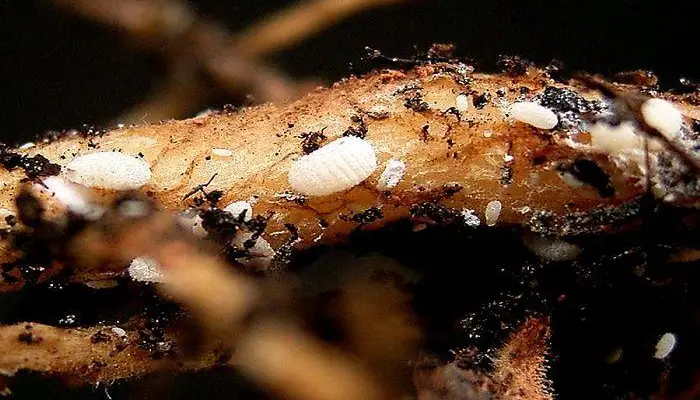
- At the beginning of an infestation, root mealy bugs are difficult to detect. Thus, you can identify some signs of deterioration in the plant as it ages.
- After the soil is completely dry, check for any insects in the soil before watering. When the soil is wet and the particles are intact, it is difficult to identify them.
- Yellowish coloration appears on affected plant leaves as the insect population increases. If the roots of the plant are damaged, the foliage may also wilt and die.
- You will notice blue tinted soil around your jade plants if they are infested with root mealy bugs. It is the waxy filaments of insects on the soil surface that cause this color.
- Root mealy bugs cause jade plants to grow slower due to their health implications. You can recognize affected plants by stunted growths.
- Around the roots, there will also be a cotton-like build-up.
- A severely affected jade plant begins to wilt and doesn’t improve after being watered.
What Causes Mealybugs?
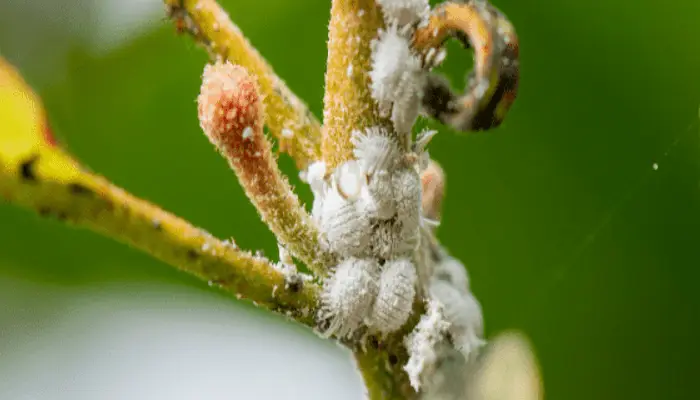
Generally, mealybugs prefer plants that are high in juices. It is particularly common to find mealybugs on citrus trees, as well as on some commercial crops like mangoes. Moreover, the mealybug can infest a wide variety of indoor houseplants, particularly tropical ones.
You may see mealybugs on your plants if you overwater and overfertilize them. Additionally, plants with high nitrogen levels and soft growth attract mealybugs.
How To Get Rid of Mealybugs on Jade Plant?
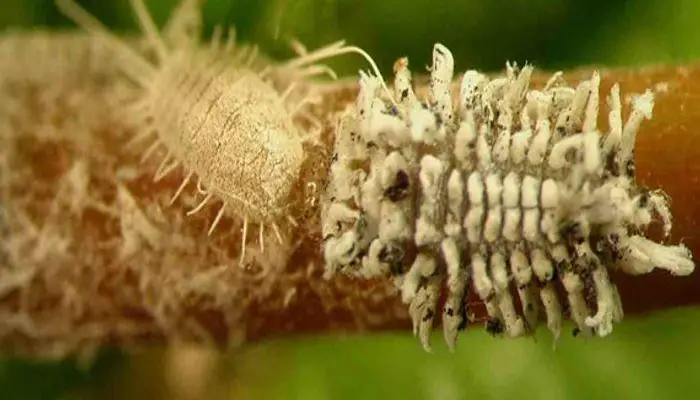
As you can see, mealybugs are dangerous to your plants. Your only option is to get rid of them in order to save your plant. Therefore, in this section, we will discover how to get rid of mealybugs and root mealybugs.
Ways to get rid of mealybugs on Jade Plants
1. Wash Mealybugs Away
With a steady stream of water, you can dislodge mealybugs. If necessary, repeat the treatment. Some plants cannot tolerate this kind of vigorous treatment, so it is best for light infestations.
2. Use Isopropyl Alcohol
With a cotton ball soaked in rubbing alcohol, wipe the mealybugs to kill and remove them. Make sure the solution contains no more than 70% isopropyl alcohol. Also, test it on one leaf before applying it to the entire plant.
3. Spray With Insecticidal Soap
You can purchase insecticidal soaps (such as Safer’s Insecticidal Soap). Also, you can use a dish detergent such as Ivory Liquid to make your own. However, ensure that the product you choose is free of perfumes and other additives that might damage your plants.
To begin, mix 1 teaspoon of soap per gallon with water, then increase the concentration as needed. Spritz the soapy solution on the plants.
4. Use Neem Oil
As long as neem oil is used as directed, it affects insects’ feeding abilities and acts as a repellent. Also, Environmental Protection Agency recommends using neem oil on vegetables, ornamentals, and edible plants.
5. Introduce Predatory Insects
Natural predators of mealybugs include lace bugs, lacewings, and parasitic wasps (Leptomastix dactylopii). Typically, they are used outdoors or in greenhouse situations and are available from commercial online retailers.
6. Use Homemade Insect Spray
You can make a garden pesticide at home. To do this, mix one garlic bulb, one onion, and one teaspoon of cayenne pepper in a food processor or blender. Add 1 quart of water to the mixture and steep for 1 hour.
Using a cheesecloth, strain the mixture and add one tablespoon of liquid dish soap. Then mix well. Moreover, in the refrigerator, you can store the mixture for 1 week. After that, you can apply the solution to plant parts where mealybugs are present.
7. Use Synthetic Chemical Pesticide
Mealybugs are protected by wax which makes some stronger insecticides less effective. However, when using stronger chemicals, be careful, especially indoors. As human health can be adversely affected by stronger pesticides
Ways to get rid of root mealybugs
Using neem oil, mix 1 1/2 teaspoons of raw neem per quart of emulsified water and soak the plant’s soil. Apply the mixture to the soil every three weeks as the mixture remains active for 22 days. It enters the plant’s system as neem gets absorbed from the soil, killing other pests infesting the plant.
Another method of removing mealy root bugs is to sterilize the roots and repot them. Take the plant out of its pot and remove the soil from its roots.
For ten minutes, soak the roots in hot water between 115° and 120° F, and sterilize the pot with hot water or alcohol. To re-pot, a jade plant, use fresh soil. Also, you can mix diatomaceous earth into potting soil to kill any remaining insects and eggs.
How to Prevent Mealybugs
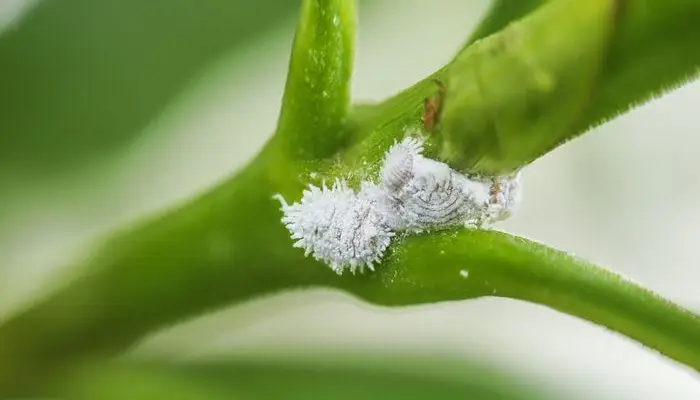
The best way to control mealybugs is to take a defensive approach. Strong, vigorous plants are less likely to be infested than weak, underpotted, and stressed plants. So, make sure your plants are healthy, and you will reduce your chances of attracting these pests.
However, mealybugs can also infect healthy plants. Often, they come on newly planted plants, since greenhouses are the perfect breeding grounds for them. So, if you are adding a new plant to your collection, please check it carefully before adding it.
Other strategies you can use to prevent mealybug infestations on your plants include:
- Mealybugs may be prevented by reducing feeding and watering since nitrogen levels are reduced and growth is hardened.
- The use of neem oil in a leaf shine solution can prevent mealybug infestations on certain plant species.
- Regular spraying with hard blasts of water can prevent mealybug infestations on plants that can tolerate such treatment.
- If your indoor plants can tolerate it, drop night-time temperatures to 60℉ to discourage mealybugs.
Note: It may be necessary to destroy the plant if the infestation cannot be controlled after two or three weekly applications of insecticide.
Black Sooty Mold
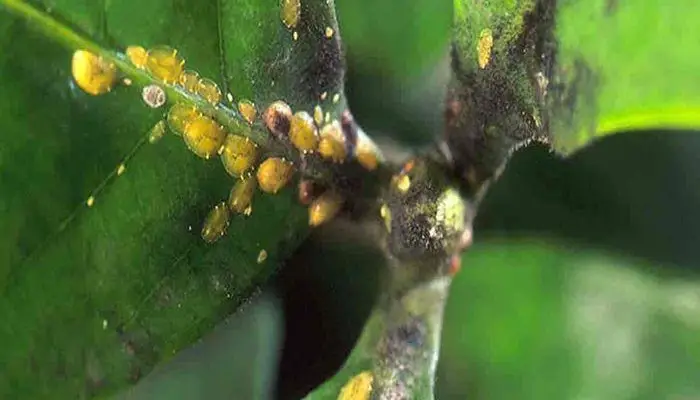
In our earlier discussion, we mentioned that mealybugs can cause black sooty mold. It is possible for your plant to get ill from the mold. Thus, you need to treat the mold as well as the plant.
The best way to do this is to use a high-pressure spray. This will remove all the loose mold spores and sooty residue.
If the mold won’t come off, mix mild dish detergent with distilled water. Spray the mix over any moldy areas with a spray bottle. Use the spray without fear. As it is important to soak the areas thoroughly.
Once again, spray the plant with water to get rid of the soap mix. Hopefully, it will also remove the mold. Yet, if there is still mold in any areas, trim it off.
Conclusion
The infestation of mealybugs is unpleasant, and no gardener or plant parent wants to deal with it. If you find them, you should get rid of them quickly so that the infestation doesn’t get worse or spread to other plants in your garden or houseplant collection.
If you spot small insects or webs on your plants, then you should inspect them regularly to prevent mealybug infestations.
Using these guides, you will discover all the remedies and everything you need to know to get rid of mealybugs.
Before you go, let us know your best mealybug remedies in the comments.
Has your jade plant been infested with mealybugs? Do you want to fix them? This article is worth reading.
FAQs
Q1. Do mealybugs attack jade plants?
The mealybugs love jade plants. Make sure your plant is healthy and keep an eye on it to prevent these pests.
Q2. What is the mealybug’s life cycle?
Mealybugs have a 30-day life cycle. Because of this, it’s important to treat your plant one or two times a week until they are all gone.
Q3. Do insecticides work on mealybugs?
Mealybugs can be controlled with insecticides, but they should be used as a last resort. To avoid fumes, make sure to use insecticide on indoor plants.
Q4. How do I get rid of mealybugs and ants?
The mealybug excretes sugary honeydew after feeding on plants. As a result, ants are attracted to this. If you get rid of the mealybugs, the ants will disappear as well.

